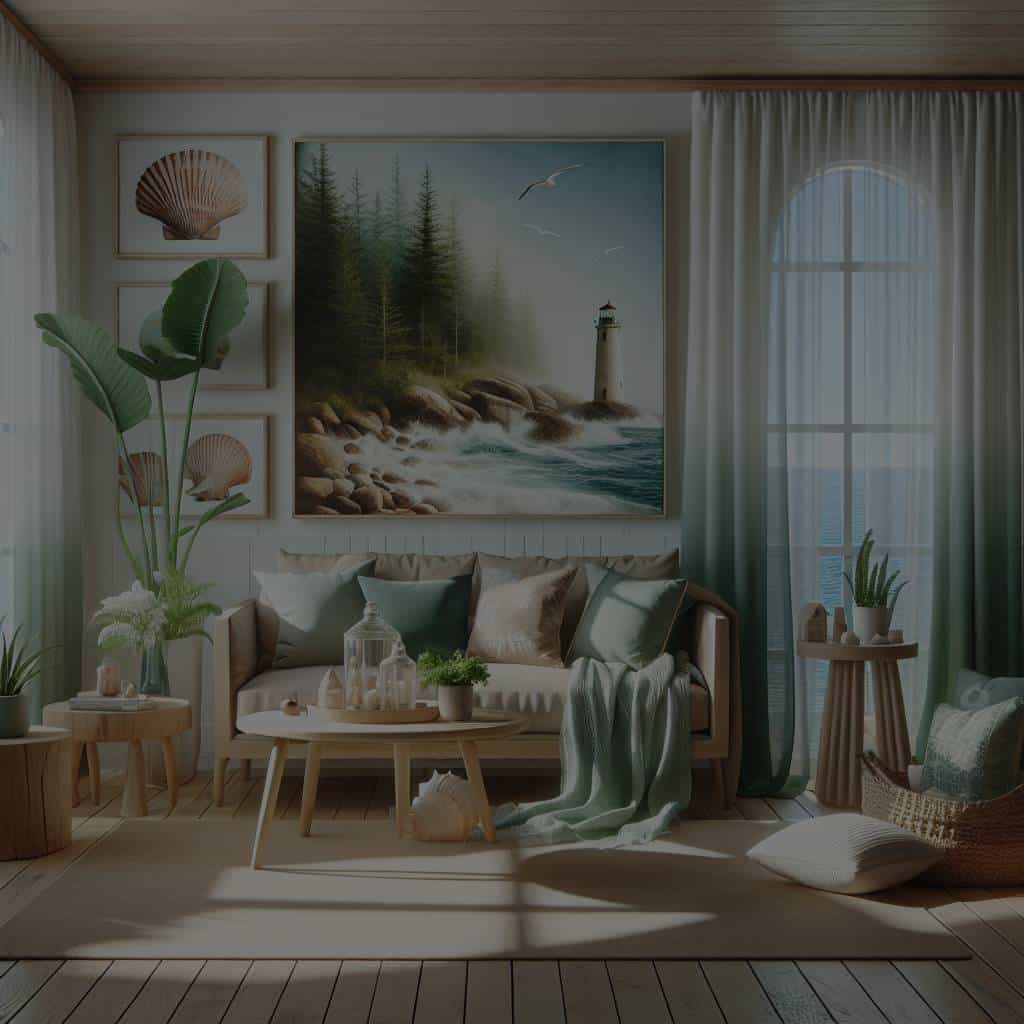How to Choose the Perfect Palette for a Serene Coastal Themed Living Room?

You don’t have to live by the seaside to bring a coastal vibe into your home. A well-crafted coastal themed living room can transport you to the beach, creating a space that is tranquil, relaxing, and full of natural beauty. The palette you choose will play a pivotal role in the final image you create.
Choosing Your Base Color
As you begin to design your coastal themed living room, your initial step should be choosing a base color. This color will lay the groundwork for everything else you bring into the space. It is essentially the largest color component in your room and often is applied to the walls.
Topic to read : What Are the Practical Steps for Setting Up a Work-from-Home Station in a Studio Apartment?
Traditionally, white has been the base color of choice for coastal interiors. It’s light, it’s airy, and it does an excellent job of reflecting natural light around the room. However, white is not your only option. Pale grays and creams can also serve as fantastic base colors, adding a bit more depth and warmth to the space.
When selecting your base color, consider the amount of natural light your room receives. If it’s a darker room, leaning towards the lighter end of the spectrum can help brighten the space. For rooms with plenty of light, you may opt for a darker hue to create a more cocooning, cozy effect.
In the same genre : What’s the Best Way to Incorporate Eco-Friendly Geothermal Heating into a Home Renovation?
Incorporating Accent Colors
Once you’ve chosen your base color, it’s time to bring in accent colors. These are the colors you’ll use in smaller doses to add character and interest to your coastal living room design.
The most commonly used accent color in coastal design is blue. From the palest sky blue to the deepest navy, the spectrum of blues is reminiscent of the sea and the sky, both key elements of coastal imagery.
However, you’re not limited to blues alone. Greens, particularly sea greens and minty hues, can evoke images of lush coastal foliage and shimmering sea glass. Don’t overlook the power of neutrals either. Sand-colored beige, driftwood brown, and even rugged slate can all play a role in creating a rich, multi-layered coastal palette.
Remember, the goal isn’t to use every color available, but rather to create a harmonious palette that feels natural and calming.
Adding Pattern and Texture
After selecting your base and accent colors, consider introducing pattern and texture into your coastal living room design. This can infuse your space with a sense of natural, tactile richness that colors alone might not achieve.
You could opt for a striped rug that mirrors the linear patterns of the beach, or a cushion with a seashell or starfish motif. Natural materials such as linen, jute, and rattan can also bring texture to the space, enhancing the coastal feel.
Using Light to Enhance Your Palette
Light plays a huge role in coastal interior design. Not only does it affect how colors are perceived, it also contributes to the overall atmosphere of the space.
When designing your coastal living room, think about how you can maximize natural light. Light colors, mirrors, and reflective surfaces can all help to bounce light around the room. At the same time, a layered approach to artificial lighting – using a combination of ceiling lights, wall lights, table lamps, and floor lamps – can create a warm, inviting glow even when the sun has set.
Creating a Cohesive Look
While it’s important to choose colors, patterns, and textures you love, it’s equally important to ensure they all work together to create a cohesive look. Even the most beautiful colors can feel jarring if they’re not properly balanced.
Aim for a mix of light, medium, and dark tones, and consider how you’ll distribute them throughout the space. Will your largest pieces of furniture be in your base color, your accent color, or a blend of both? How will your patterns and textures play off each other?
Remember, the goal is not just to choose a perfect palette, but to use it in a way that brings harmony, peace, and a sense of coastal serenity to your living room.
Selecting the Right Paint Brands and Finishes
After settling on colors for your coastal living room scheme, the next crucial step is choosing the right paint brands and finishes. Brands like Benjamin Moore and Sherwin Williams offer high-quality paints in a wide range of colors, making them excellent choices for your coastal palette.
Benjamin Moore offers a robust collection of blues, from soft pastels to deep navies. Their "Beach Glass" hue is a beautiful blue-green that can evoke the calming visuals of sea glass. Pair it with a neutral cream or soft white for a balanced look.
Sherwin Williams, on the other hand, boasts a range of crisp whites and warm neutrals perfect for your base color. "Eider White" is a popular choice, with its muted, gray undertones it offers a modern coastal approach.
When it comes to finishes, a flat or eggshell finish works well for walls, as they help diffuse the light and create a soft glow. Semi-gloss or gloss finishes are excellent for trim and moldings, as they provide a nice contrast and bring out architectural details.
Before making the final decision, sample the paint colors in your room at different times of the day. The lighting conditions can greatly affect the color’s appearance. Remember, it’s all about creating a soothing, relaxing space that embodies the spirit of the coast.
Thoughtful Decor Selections and Room Ideas
Once you’ve established your color scheme, it’s time to consider the smaller elements that will help bring your coastal living room ideas to life. Start with your furniture. Opt for pieces that have a casual, lived-in vibe. Think slipcovered sofas, weathered wood coffee tables, and accents of natural material like rattan or jute.
Next, consider your decorative elements. In a coastal living room, less is often more. The focus should be on creating a relaxed, uncluttered space. Choose pieces that echo the colors and textures found at the beach. This could include throw pillows in your accent colors, coral and shell accents, or artwork depicting seascapes or marine life.
Lastly, don’t forget about the floor. A natural fiber rug in a neutral color can tie the room together, adding texture and warmth. Alternatively, a rug with a subtle nautical stripe can add a playful yet chic touch to your coastal design.
Conclusion
Creating a coastal-inspired living room can be an exciting and rewarding project. From choosing the perfect color palettes to incorporating natural materials, there’s a lot to consider. However, the process should be enjoyable and creative, mirroring the relaxed and tranquil atmosphere you aim to create.
Remember, the goal is to produce a harmonious, calming space that feels natural, welcoming, and intrinsically coastal. By choosing the right base color, accent colors, and textures, you can transform your living room into a serene coastal retreat.
Whether it’s a crisp white from Sherwin Williams, a soothing blue-green from Benjamin Moore, or the addition of natural textures like jute and rattan, each element contributes to the overall coastal theme. The result? A living room that brings the serenity of the coast right into your home, no matter where you may be located.
